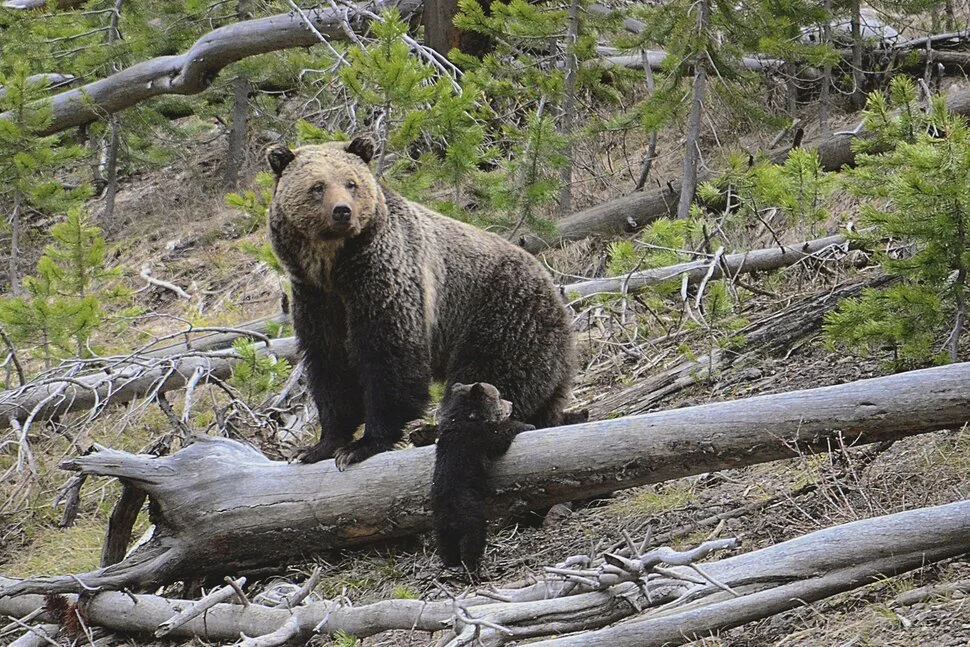BILLINGS, Mont. (AP) — The Biden administration announced on Wednesday that it will continue to protect approximately 2,000 grizzly bears in the Rocky Mountains despite opposition from Republican-led states.
Federal officials also revealed that they would ease some restrictions as conflicts between bears and humans increase. Ranchers operating outside designated grizzly recovery zones will now be allowed to shoot bears that attack livestock or dogs. Additionally, state officials could be given the authority to capture and relocate bears to prevent potential conflicts.
Protections will be lifted in states where grizzlies are no longer present, including California, Colorado, New Mexico, and Oregon.
These changes may be revisited under the incoming administration of President-elect Donald Trump.
Details of the decision by the U.S. Fish and Wildlife Service were obtained in advance by The Associated Press.
Grizzly bears, which can weigh up to 800 pounds (363 kilograms) and live more than 25 years, have been protected as a threatened species across the lower 48 states since 1975. The Trump administration sought to remove these protections during its first term, but those efforts were blocked in court.
Republican leaders in Montana, Idaho, and Wyoming began petitioning the Fish and Wildlife Service in 2021 to reclaim state management of the grizzly population. Such a move could pave the way for hunting, although state officials have argued that hunts would be limited and would not threaten the overall population.
Federal officials indicated that they are working toward removing protections but declined to specify a timeline.
“This reclassification will facilitate the recovery of grizzly bears and provide a stronger foundation for eventual delisting,” said Martha Williams, U.S. Fish and Wildlife Service director, in a statement.
The agency also announced it will solicit public comments on whether hunting could be used to mitigate conflicts between people and bears. A potential exemption from provisions of the Endangered Species Act would be required for this, and it is expected to face legal challenges from environmental groups. Public comments will also be sought regarding the newly relaxed rules for shooting bears that threaten livestock.
The administration’s decision was met with strong criticism from Montana Rep. Ryan Zinke, who had previously worked on an effort to remove protections for bears when he served as U.S. Interior Secretary under Trump.
“There’s no denying that the Biden administration rushed this through in its final days, knowing it’s a political move to appease radical environmentalists,” Zinke said. “Thankfully, the political figures pulling the strings at the U.S. Fish and Wildlife Service are about to be replaced.”
Wyoming Gov. Mark Gordon, Montana Gov. Greg Gianforte, and some members of Congress also voiced opposition to the decision, while wildlife advocates welcomed it.
“The Fish and Wildlife Service rightly followed the science,” said Andrea Zaccardi from the Center for Biological Diversity.
Grizzly bears have greatly expanded their range in recent decades, including parts of western Washington state. This expansion has resulted in more conflicts with livestock and, on rare occasions, with humans.
U.S. government scientists determined years ago that the grizzly population in certain western regions — including around Yellowstone and Glacier National Parks — had biologically recovered. However, there has been concern that state wildlife laws may not be sufficient to protect the species.
Chris Servheen, a former Fish and Wildlife Service grizzly recovery coordinator, emphasized that continuing protections will allow the species to expand into new areas. Without such safeguards, he warned, grizzlies could once again be driven toward extinction due to climate change and state policies that could reduce bear populations.
“We spent about $30 million and 45 years recovering grizzly bears to where they are today. If they are delisted, it would undo that progress, and they could once again be on the brink of extinction,” Servheen said.
Once numbering as many as 50,000 grizzly bears across 18 Western states from Texas to the Canadian border, their population dwindled due to overhunting and trapping. By 1975, only around 700 to 800 grizzlies remained in the lower 48 states.
Thanks to intensive recovery efforts led by the U.S. Fish and Wildlife Service, the grizzly population in the lower 48 states has now surpassed 2,000, with larger populations in Alaska, where hunting is allowed.
Even in areas where hunting is prohibited, human activity remains the biggest threat to grizzly bears. Annually, dozens of bears are killed by wildlife agents in response to livestock attacks, shot by hunters in self-defense, or struck by vehicles or trains.
When grizzly protections were temporarily lifted in the Yellowstone region in 2017, hunts were scheduled in Wyoming, where nearly 1,500 people applied for 12 grizzly bear licenses. Idaho issued only one license. However, a court order blocked the hunts just days before they were set to begin.
In the years following, federal officials have raised concerns about state laws in Republican-led areas that could harm grizzly populations. For example, Montana passed a law allowing grizzlies to be killed if they attack livestock.
Montana and neighboring states have also implemented aggressive policies toward gray wolves, including relaxed wolf trapping rules that some scientists fear could result in grizzly bears being inadvertently trapped and killed.
In 2021, federal scientists concluded that protections were still necessary due to human-caused deaths. After further consideration in 2023, they confirmed that substantial evidence showed grizzlies had recovered in two designated recovery zones near Yellowstone and Glacier National Parks.
